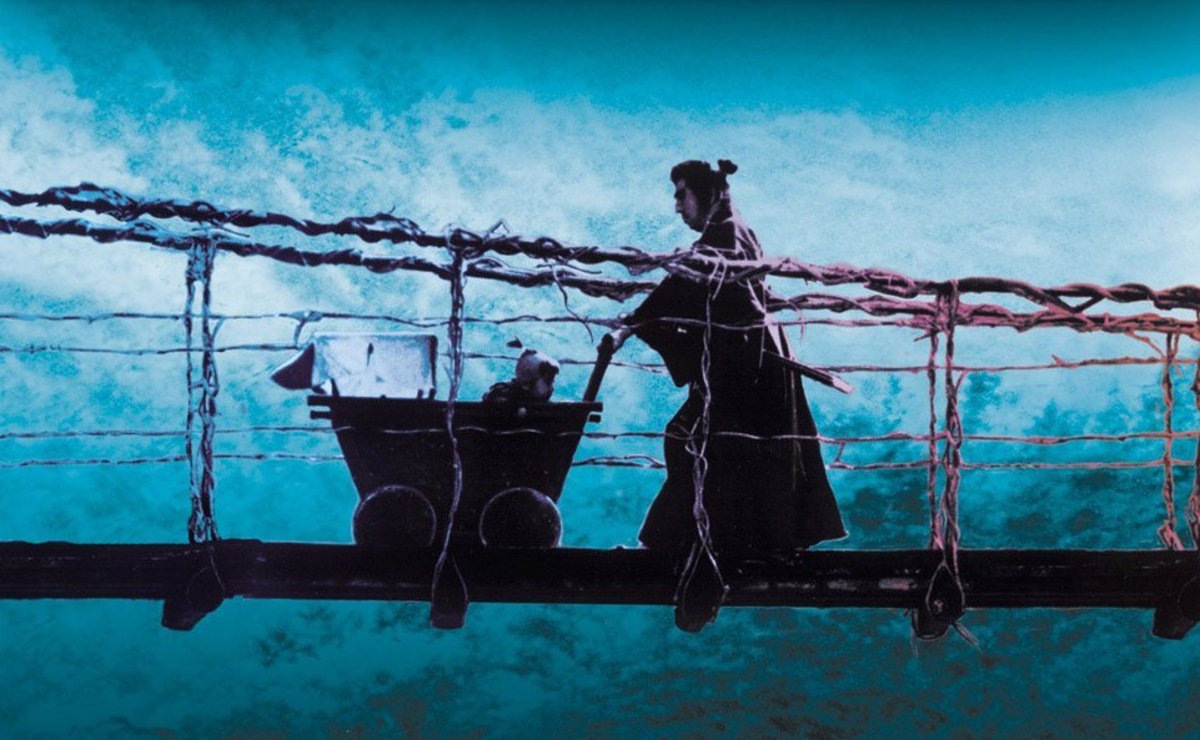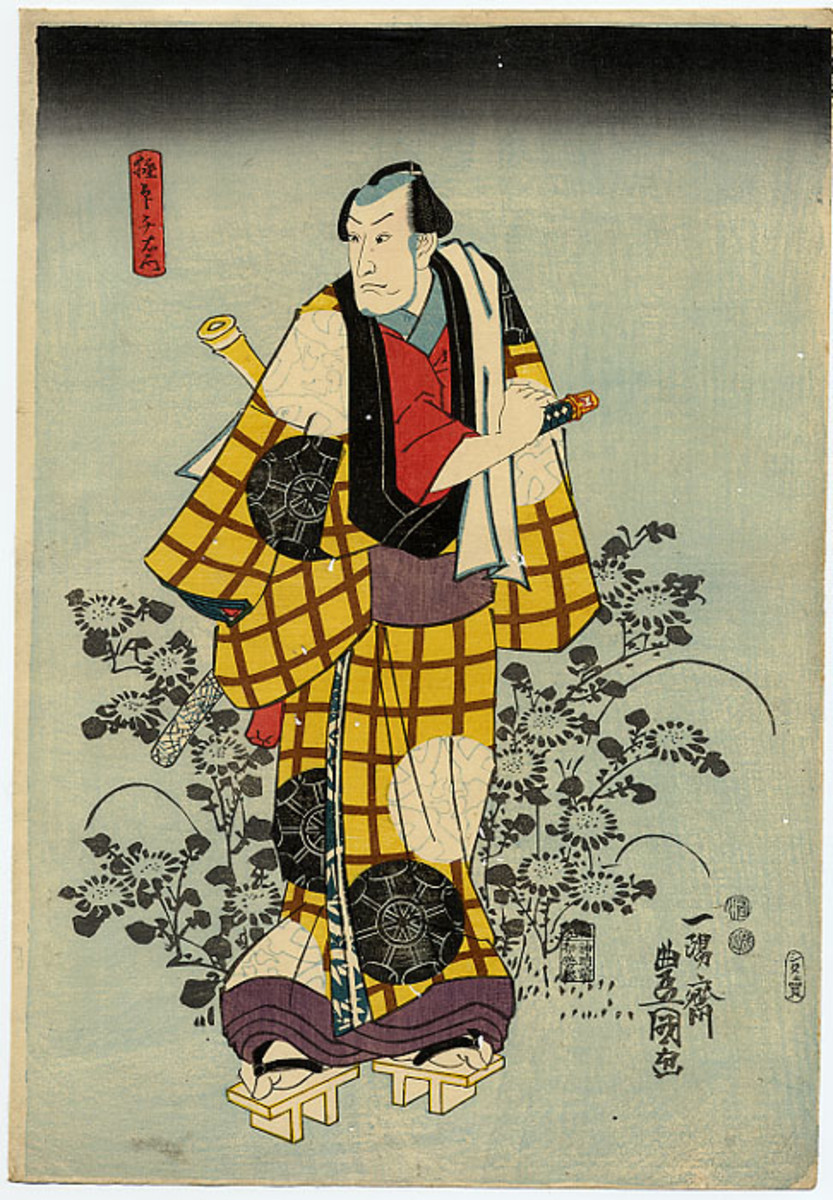"Hen-na" Italian Appears in Kabuki Show: My Unforgettable Experience
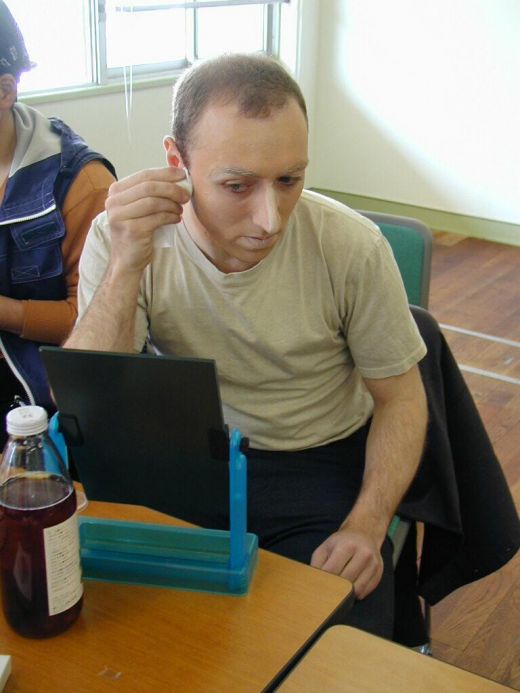
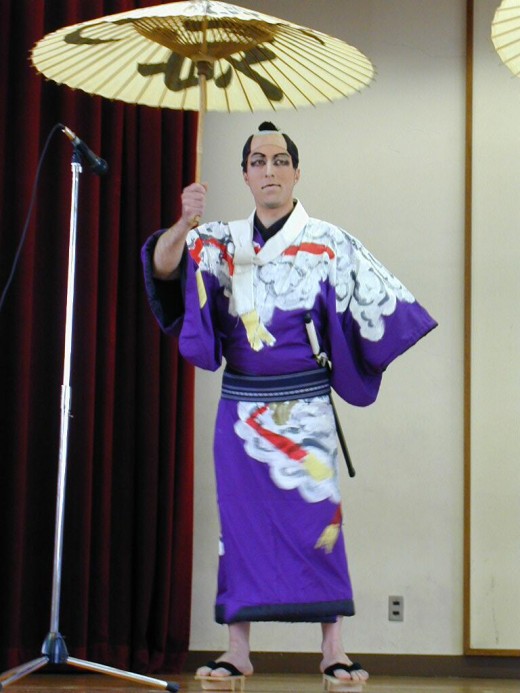
Hen-na Gaijin
Yes, it was a good night sleep. Thanks to a deep gray cloudy sky I could make it till 10.
The espresso coffee machine is set on the range. I stretch.
The shaving cream is almost finished: - `Sate, dongiri ni hikaeshi wa` - I can`t help apostrophing the orange towel to the right of the mirror. `Jingi no michi mo shirakawa no yobune e norikomu fune nusutto` - I feel the urge to add while reaching for the tooth brush.
If you are Nango Rikimaru even just for one day, this might as well change your life forever.
The story begins exactly 12 months ago in the fall of 1999. It was on a Saturday and I decided to go to assist to a `village kabuki` (nouson kabuki) performance.
The Japanese culture is really fascinating: especially that deep rooted, popular world known as `shitamachi`. Rather than being just a spectator, the most rewarding experience is managing to be part of a real situation.
To enter into the frame as a member of the community. Of course it is very difficult for gaijins to step down from their sticky pedestal. Even when you make every effort to speak all the kansai-ben you know, you remain a gaijin, an outsider. The Japanese like to categorize, to organize concepts. How to label a 'non-hamburger eating' gaijin who shows proudly his red underwear (aka-hundoshi) on a rural theatre stage?
'Henna gaijin': this is what I am. 'Okashii gaijin' would have a broader range of meanings, from funny visitor to outlaw barbarian. 'Hen' leaves less space for euphemistic interpretations: it means 'strange foreigner', maybe even a little suspicious.
This 'hennism' was already incubating in me last year, when after venturing for a couple of hours on 'very local' train. On a fine day in October the sun is tepid and the air is cool. The body is almost surprised by a sensation of diffuse well-being
The winding narrow road was approaching a hamlet and I noticed many people were crossing a rice field on a narrow path, going up a flight of stone stairs, and disappearing in the thick grove.
Others were eating o-bento in small groups scattered in the field. I took out my camera to try to capture this bucolic atmosphere. I started to scan my preys in the viewfinder. Hey! I spotted some guy with a purple kimono and a white face walking tranquil between the sheaves. Ara! Ten meters back another spirit is drinking tea with a straw while balancing a leisurely decorated karakasa (traditional umbrella) on the shoulder. I stepped inside the dream.
The audience is delimited on the sides by a triple row of shoes and on the back by a tangle of tripods and 300mm zoom lenses. The stage, covered by a straw roof becomes visible by turning back 180°.
After 2 servings of chikara udon, the show started. The program was opened by 'kodomo no kabuki': elementary school children gave proof of their performing ability in bright green kimonos, with a reddish heavy make up.
The second part was the famous 'shiranami go nin otoko'. The hanamichi – an approach to the stage in form of a bridge - consisted of three planks of wood: it was very narrow and sunk dangerously under the weight of 4 obaachan-samurai (of which 3 'roundish') and a hairy young farmer.
The children also took part as the `wakiyaku` (cast) and everything was over in less than 15 minutes. The experience was very enjoyable, but what really left a deep sign was the overall atmosphere, sacred and homey at the same time.
The vision of the actors crossing the rice field with their umbrellas, while approaching the stage was still engulfing my poetic gland and I left without realizing my notebook and my autumn-leaves collection remained on the floor. Some kind soul found it and telephoned even before I realized I lost it.
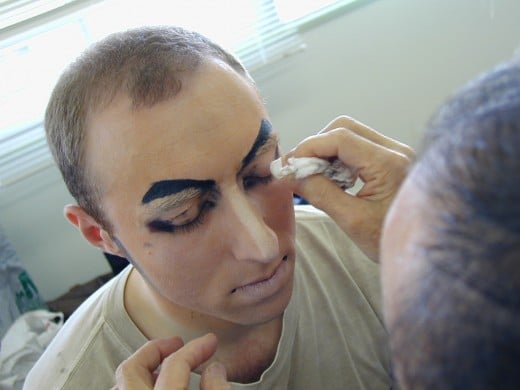
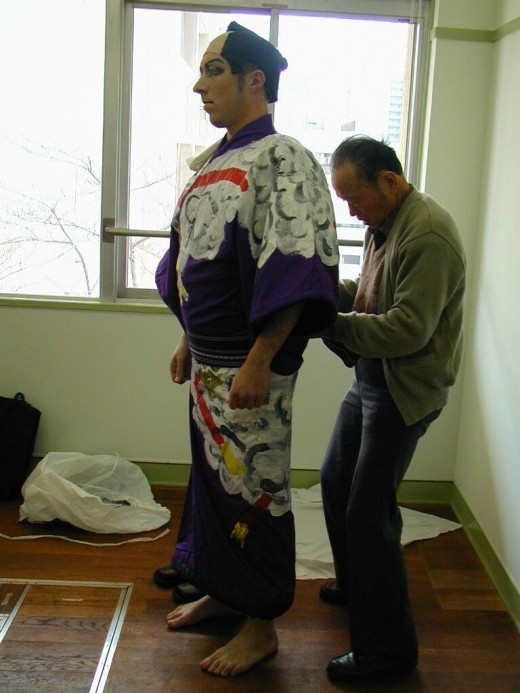
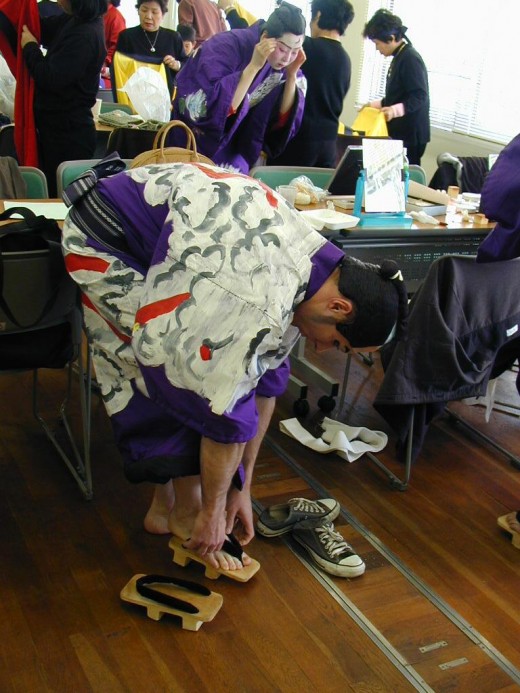
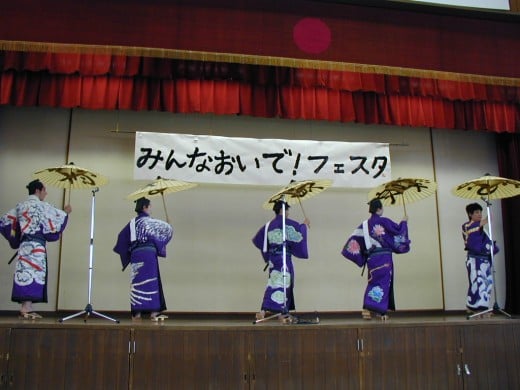
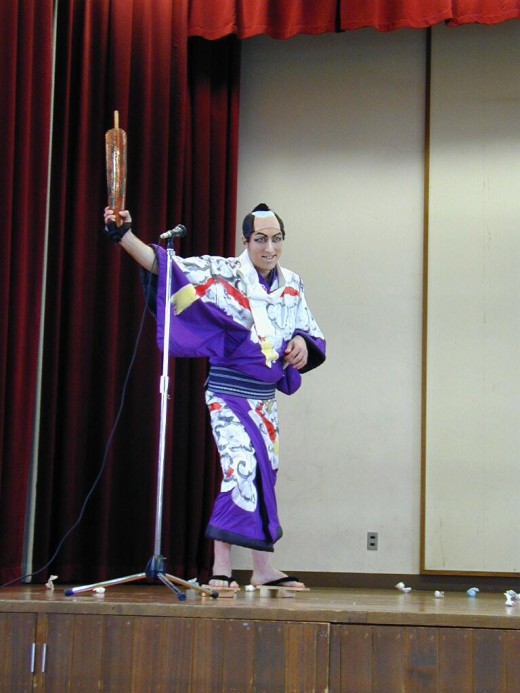
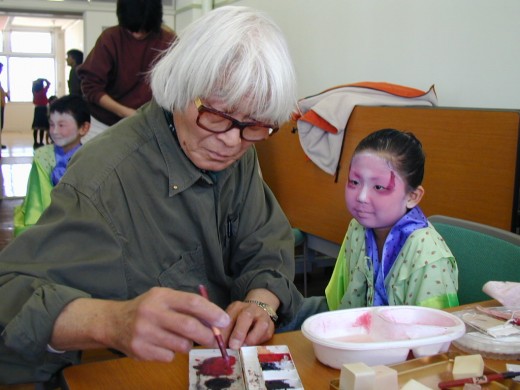
One year later....
After that day, I did not hear about kabuki for about until this September. I returned to Italy for a brief vacation dedicated to placate the family and solve bureaucratic enigmas. One day I received an e-mail, half in Spanish, half in Japanese with the title: 'kotoshi no kabuki ni demasenka?'
Of course my answer was an enthusiastic YES!
Once returned to Japan, I received a postal package with a videotape artistically wrapped in a furoshiki, and three pages with the words of 'Shiranami gonin otoko'.
The organizer decided to refresh a little the cast this year, by inserting within the 3 'roundish' samurai formation, a DJ from AM Kobe (a radio station) and a gaijin. The roles of Juzaburo, Tadanobu and Nippon Daemon were already taken. The choice was between Rikimaru and Benten.
I decided to postpone every important decision to after I could absorb the jet-lag. In any case, the DJ chose first and I automatically became Rikimaru.
My girlfriend was cooperative and noted for me the furigana and -more or less- the meaning of all the lines.
Nango Rikimaru is a thief and an assassin. There, where the salty wind blows between the bent pine trees, there he goes, in spite of any human piety, during the night he jumps on the ships at anchor in the port. During the navigation, when the waves are cut into shining foam, he comes out from his hiding place, threatening the crew with his flashing sword. A life of crime and violence. Coming close to the end, every man with such a heavy conscience should feel the pains of the guilty. But Rikimaru, in spite of every human and divine rule proudly does not care, actually he provokingly does not remember. He hates to pray.
Do not ask me why, but I immediately liked this 'urusai yatsu' (obnoxious character).
The date for the show was set for the 14 October and we met at the beginning of the month at the site.
After changing 2 trains, 5 minutes walk from Kizu station, I could reach the kensouninken jinja. The site does not have the special magic of the previous year, but is nonetheless a charming setting.
During the following week, after transferring from a cassette-tape to a digital MP-player the words of Rikimaru, I started to listen with the repeat option switched on. First I was repeating whispering, then with a rough and caricaturing tone of voice, than I tried to concentrate more on the rhythm, which resembles slightly the accent of people from Genova, in Italy. The acoustics of the bathroom are undoubtedly the most comfortable to enter in the atmosphere, but I also did some rehearsals on the train and while riding my bicycle.
On our first and last trial, one week before the big day, one of the `samurai` brought there a TV set and I could finally see the fierce moves of Rikimaru for the first time. The impenitent thief make his appearance with a deep swing of his umbrella, he pulls up a corner of his kimono to uncover the left leg and stomps the ground with his heavy `geta` sandals. My awkwardness in trying to repeat the action provoked the national pride of the construction worker who gave me some insights about the way a real samurai should joggle an umbrella. Some people, looking at my face and fair hairs for the first time, looked sincerely disappointed and argued I should have rather impersonated Benten, not Nango. No, no way I could be a convincing Nango Rikimaru!
The meeting ended with some home made onigiri and some leftover oden somebody brought for lunch. As we parted, the `three musketeers` split to go to hang some advertisements.
Finally, Saturday, the 14th of October I was ready for the happening. I found some posters with my name – as a special guest – in the train station in Kobe and I could not help taking a couple of pictures with the auto-shutter (typical of a real kamera-baka). I arrived just in time for my ration of matsutake gohan and home made tsukemono.
The power of the make-up is really incredible. I could hardly recognise the others: everybody could acquire an aura of dignity and a powerful expressivity; even if Benten – the radio station DJ – lamented he felt he was looking more like a jochuu (samurai servant) or a ryokan maid, rather than a real samurai.
The vestition was coordinated by an ageless woman who was introduced to me as an expert in kimono matters. After wearing a red agajiban (silk shirt) and tying around the waist the above mentioned red hundoshi (underwear), Rikimaru`s round belly was built-up with 2 large and 2 medium size bathtowels and tied up firmly with energetic but elegant moves. The kimono had been refinished and painted with the theme of a dragon coming out from a tentacular cloud. This choice was - who knows why? - presented to me as an homage to my Italian background.
We left the two 10-tatami rooms where we changed and wore our normal shoes to avoid using the geta sandals on the dusty road sloping down towards the shrine.
After this surrealistic 500 meters promenade, everything proceeded incredibly fast and the show reached the end just when I was barely taking conscience of the situation. Let`s go a little bit back in slow motion:
We crossed the audience to reach our position behind a curtain, by the hanamichi (which consisted basically of a ramp, about 5 meters long, connecting to the stage).
Chanting music started in playback and we had to come out one by one. I planned to swing the umbrella as soon as I was out, to demonstrate all my misanthropy, but there were only maybe 50 cm between the curtain and the public: I could barely shift the head from left to right a couple of times and step up on the hanamichi to find my place, back to the public, with the right hand resting inside the sleeve. Benten Kozou Kikunoske alias Danroku-san (the DJ) moved first on the stage, as it was not possible to recite – as it should be done – the first part while on the hanamichi. Tadanobu Rihei, alias Katou-san (the organizer of the event for the past 8 years and performer for contingent reasons since last year) followed. After, in order, Takao-san impersonating Akaboshi Juzaburo, Nango Rikimaru and Nakamoto-san, in the clothes of Nippon Daemon, who walked across the stage to reach the first position.
What to say? The words come out without too many hesitations, but I found it very difficult to speak up while keeping the rhythmic intonation forged in the bathroom. After concluding their speech, the actors close their umbrellas and prepare for the combat with the children who are advancing from the back lines. The slaughter ended with an applause and – as said before – I was very surprised and almost disappointed that it was it.
AFTERWARD
I missed Rikimaru after that day, for I thought it would be my only encounter with him. But thankfully, it has been 10 years since I first made an appearance on a village kabuki stage and I have been invited to perform multiple times. Each time I feel closer to that “urusai yatsu” and portray him just a little better than before, but more than that, I am honored to be part of a fading tradition in Japan.

